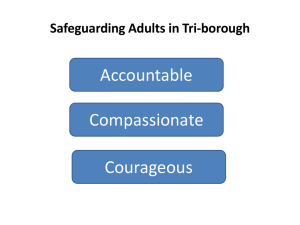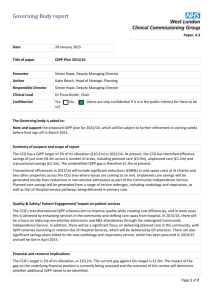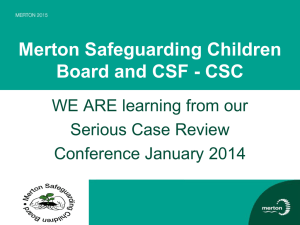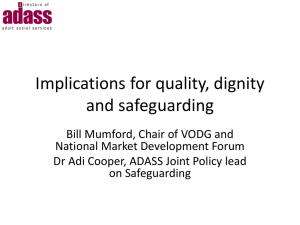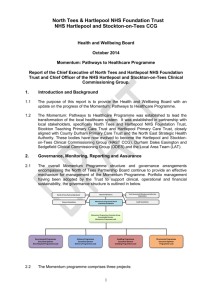Our Health Challenges - Stockton-on
advertisement
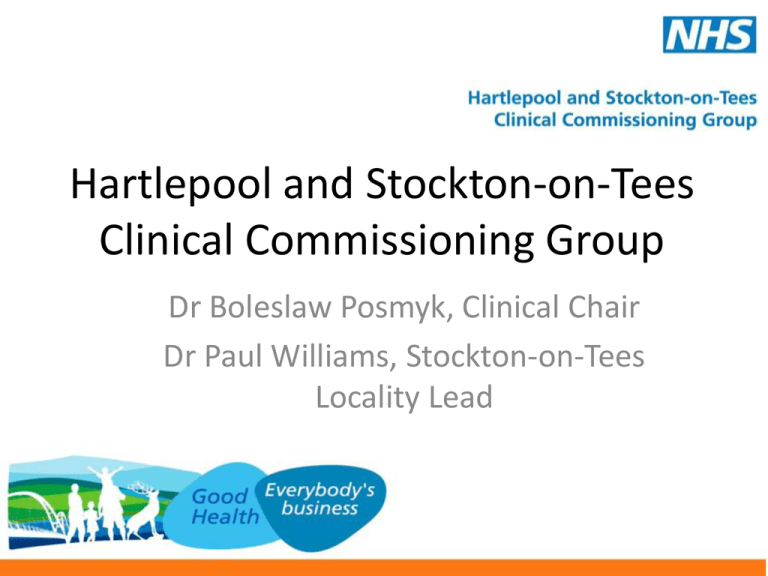
Hartlepool and Stockton-on-Tees Clinical Commissioning Group Dr Boleslaw Posmyk, Clinical Chair Dr Paul Williams, Stockton-on-Tees Locality Lead What we aim to do in our presentation Describe to you: • Our journey so far • The people we work with and on behalf of • Our challenges, opportunities and risks • Our plans for improvement • How we do things around here: Our decision making and our leadership Meet our Team • We are a membership organisation of 40 general practices with devolved decision making to our Governing Body • Our team has a strong clinical focus, bringing together a broad range of skills and experience together with a passion for improving the health outcomes of our communities Our Journey Two pathfinder groups – Hartlepool and North Tees Merged into one CCG (40 General practices) April 2012, with first Shadow Governing Body meeting as a sub-committee of NHS Tees Rationale for coming together: • Shared vision and values • Similar health needs, levels of deprivation, challenges • Share acute, community and mental health providers • Avoids duplication • More financially robust • Increased pool of clinicians willing to take on lead roles • Small enough to maintain effective practice engagement through strong locality focus and co-terminosity with LAs • Offered potential for synergy and sharing of good practice • Still able to work effectively with neighbouring CCGs especially South Tees Hartlepool & Stockton-on-Tees CCG Population c285,000 40 General Practices Hartlepool & Stockton-on-Tees CCG Population c285,000 40 General Practices Meaningful Engagement - Our Stakeholders How we are working “together” Health and Wellbeing Boards Stockton-on-Tees Borough Council Hartlepool Borough Council Local Safeguarding Children's Boards 40 Member practices Providers Safeguarding Adults Boards / LD partnership Public Health Community Groups Patient participation groups Clinical Networks LINks/ Healthwatch NHS Commissioning Board/LAT Voluntary Sector Professional Clinical Leadership Other CCG’s/Northern CCG Forum Meaningful Engagement – our communities Communication & Engagement strategy Local Events PPGs LiNKs/Healthwatch Scrutiny Forums Our Health Challenges Rank distribution of electoral wards in various deprivation groups Hartlepool and Stockton compared with England Index of Multiple Deprivation (IMD) 2010 Most affluent wards in England 7934 (7567) Ingleby Barwick East 7139 Park (6412) 6346 5553 Electoral ward rank position 4760 3967 3173 2380 1587 793 1 Most deprived wards in England (17) Town Centre Stockton A population of ‘two halves’ Dyke House (44) Hartlepool A population with little relative affluence 100% 51 to 100% 90% 11 to 50% 0 to 10% 80% 70% 60% 50% 40% 30% 20% 10% 0% England Stockton Hartlepool Ingleby Barwick Life expectancy Parkfield & Oxbridge Stockton Centre Men 78 74 69 Women 82 78 74 One of the consequences of differences in risk are differences in outcomes… Life expectancy reduces sharply within very short distances from periphery to centre 9 years for men 8 years for women The starkness of inequalities in health Our Health Challenges Mortality from suicide & undetermined injury; Cancer; circulatory disease; Gastrointestinal disease; and Respiratory disease worse than England mean High levels of deprivation Levels of health worse than Average Smoking related deaths higher than average Hospital stays for alcohol admissions higher than England average High levels of child poverty Health inequalities Life expectancy lower than average Healthy eating, smoking & obesity worse than England average Our Plan at a glance J S N A Our Vision H & W B Our Aims S T R A T E G I E S Our Values Our Work streams Our Priorities Reduced inequalities / Improved wellbeing commission high quality, sustainable and evidence based services that respond to local need, bring care closer to home and are cost effective Engagement & Patient focus Health & Wellbeing • Address health inequalities • Improve lifestyles • Focus on particular groups i.e. carers and children work in partnership to reduce health inequalities and improve the health and wellbeing of the population Quality & safety Value, efficiency and affordability Out of hospital care Acute in hospital care • Transform community care (TAPs) • Bring care closer to home • Care home managemen t & quality • Improve productivity • Choice & quality • Streamline care pathways • Reduce urgent care attendances Look for opportunities to innovate, involving users, carers, staff providers and the public in transforming services Integrity and honesty Mental Health, LD & Dementia • Develop MH/LD • Improve equity • Improve Dementia care • PHBs Courage Accountability Medicines Management • Safe, rational and cost effective use of medicines • Reduce variation S T R A T E G I C O U T C O M E S Managing Financially Sustainable Position up to 2016 Income Shifts Underlying Cost Pressures Technical Efficiency Programmes Investments 70000 60000 £’000s 50000 40000 30000 20000 10000 0 -10000 -20000 Change in Recurrent Income Future planning assumptions are: - Lower Growth Additional Costs from Inflation Expected CQUIN Payments - Increase in inflation Efficiencies from Tariff Efficiencies Demographic & from Non Tariff Demand Contracts and Prescribing - Lower Tariff Efficiencies National - Increase in demographic demand Local Our QIPP Challenge • • • Benchmarking Tools Utilised to identify outliers • NHS Comparators – emergency admissions, A&E attendances, outpatients per 1000 population • PBMA – identify high spending poor outcomes • PBR Benchmarking – identifies provider performance issues ie new to review ratios • Prescribing EPaCT • Variation in spend on specialities across Tees • Variation across practices What it told us – increasing activity in acute sector, prescribing above national average, local FTs where not performing to top quartile in some areas, significant variation in referrals, admissions and resource use across GP practices What we did – • Looked for evidence of effective improvement methods (Kings Fund, National QIPP programme, Institute of Innovation programmes, VMPS/NETs) • Engaged our practices and providers • Developed our QIPP programme around what the benchmarks told us and grouped these against our workstreams, developed our Delivery Plan • Developed our monitoring arrangments Improving Quality and Safeguarding Improving quality is at the heart of what we do • Safe and tested governance with our systems and processes • Implementation and monitoring of Quality Dashboards • Robust provider Clinical Quality Review Groups • Development of a Quality Assurance Framework for all commissioned services • Embraced Legacy Document – now preparing to receive Quality Handover Document • Committed to driving up quality in primary care - GVISQ Recognising our statutory responsibilities for safeguarding • Working with our Local Authority partners • Executive Governing Body appointment (Nurse) • Supporting our Local Safeguarding Children’s Boards and Adult Protection Committee’s Preparing for the future Sir Robert Francis Constitutional & Governance arrangements Council of members Hartlepool H&WB Locality groups x2 Governing Body Stockton H&WB Delivery team NECS Workstreams Remuneration Audit Partnership / QIPP delivery board QPF Governance & Risk Quality & Safety Group CQRG Funding panel Safeguarding Boards Capacity and Capability GP GB members & locality leads Chair Clinical Workstream Leads Chief Officer Designate / Accountable Officer Chief Finance officer Assistant Finance Managers Local NECS Team & Collaborative commissioning Executive Nurse Corporate Governance and Risk Officer Commissioning development / Deliver Manager Corporate Office Administrator Partnership & Innovations Manager Admin Support Partnership Project Officer Head of Quality and Safeguarding (designated Adults safeguarding) Designated Nurse Children’s Safeguarding Designated Doctor and LAC lead Risks and Mitigations • Clinical Engagement • Improving quality & safety • Developed different opportunities at all levels of the organisation • Strong relationships, strong governance, high awareness • Economic environment and financial challenge • Robust QIPP plans & track record of delivery, preparation, contingency, good governance • Hospital Reconfiguration / Momentum • Evidence based Clinical mandate, strong relationships with OSC, good public engagement The biggest task is alignment……….. The difference we are making • • • • Highly effective GP, public and other stakeholder engagement Winner of HSJ National award for Efficiency, Medicines Optimisation Safer Care NE; Adult safeguarding award Finalists for Commissioning Organisation of the Year (HSJ); Vision Award – use of data, NE lean Academy; spread of innovation, • • • Reduced variation in primary care - improved clinical quality Transformed community services – commissioning for clinical outcomes Progressing Momentum Pathways to healthcare; redesigning 46 clinical pathways, improving patient experience, reduced length of stay, increasing productivity QIPP delivery – securing financial sustainability •



